
views
Detaching the Drain Hose
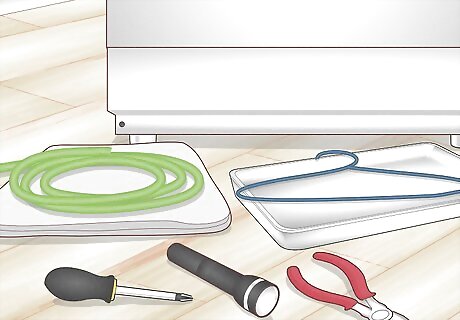
Gather your supplies. Most of the supplies you'll need to break up dishwasher clogs can be found around your home. In the event that you need to purchase any supplies or replacement parts, do so at your local hardware store. For this project, you'll need: Clean rag Flashlight (optional; recommended) Garden hose Pan (to catch water and debris) Pliers Screwdriver Wire coat hanger (optional)
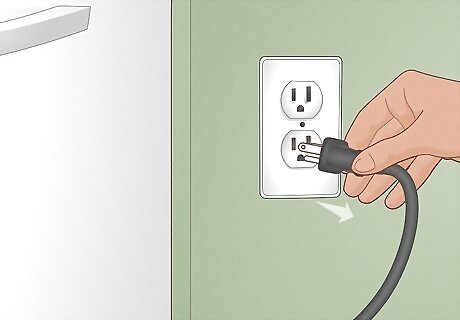
Disconnect your dishwasher from its power source. Unplug your dishwasher from the wall outlet. Dishwashers that are wired into your home's electrical supply may require you to remove a fuse from a fuse box or flip a breaker in the circuit breaker panel to "Off" to disconnect the power. Some fuse boxes may be poorly labeled. Verify power has been cut to your dishwasher by making sure it can't turn on after removing a fuse or switching off a breaker.
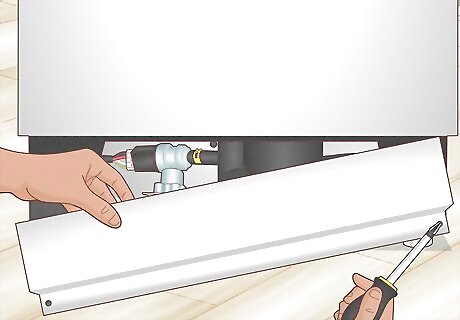
Remove the kickplate. The kickplate is a piece of metal or wood below the door of the dishwasher. Use a screwdriver to remove the fasteners connecting the kickplate if necessary. Once removed, set the plate off to the side and keep the screws where they won't be lost, like in a plastic baggie. Depending on your dishwasher model, your kickplate may use different kinds of fasteners, like snap fasteners, which generally release when pulled firmly. Some models of dishwasher may need to have the door open for you to be able reach the screws. After unscrewing, close the door and remove the kickplate.
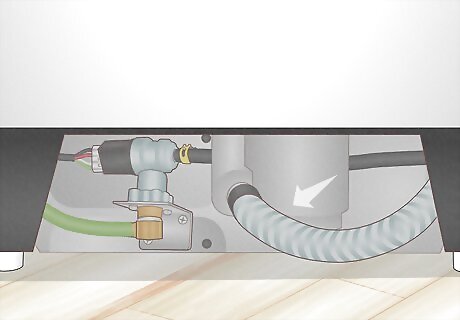
Find the drain hose. The drain hose usually ties into the sink drain. Behind the kickplate, locate the drain hose, which should run between the dishwasher pump and the drain. The dishwasher pump is usually located underneath the lower spray bar. The hose is generally made of flexible, thick, corrugated plastic. Some dishwashers may be designed so that the drain hose runs between the pump and the air gap found at the top of the sink near the faucet or directly to a garbage disposal. The spray bar of most dishwashers looks like a thin strip of metal with jets on top. Some dishwashers may have a lower and upper bar, one for each inner basket. You should notice a second hose alongside the drain hose. This is a recirculation hose, which may also have a blockage. Leave this hose for now and focus on the drainage hose.

Inspect the condition of the hose. If the plastic shows signs of brittleness, cracking, or other kinds of deterioration, the hose should be replaced. Replace hoses with kinks, as well. Replacement parts can be found at your local hardware or appliance store. Stray shards of glass can tear the hose. Kinks usually form in a hose when it is poorly supported. Use zip ties or a water resistant cord, like one made of nylon, to support areas of the hose that sag. Some models may require a special hose or connector. These parts can be ordered from the manufacturer. Find information on ordering in your owner's manual.
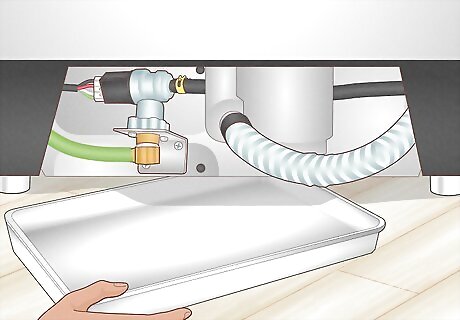
Prevent spillage with a drip pan. Place a shallow pan beneath the point where the hose connects to the dishwasher. To catch whatever might remain in the line, use things like baking sheets, paint trays, or casserole dishes. Keep a dry rag handy as you work. Water can make hardware slippery. Wipe wet hardware as necessary with your dry rag.
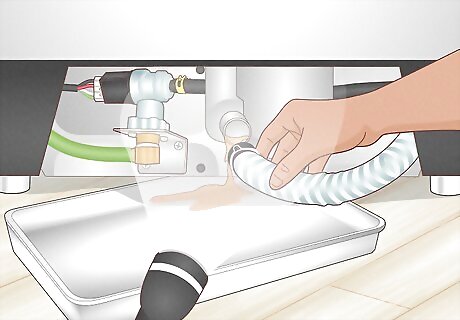
Detach the drain hose. Lay your flashlight so you can see where the hose connects to the pump. At this connection, there will be a wire clamp. Pinch this clamp with pliers to loosen it, then slide the clamp up the hose. Pull the hose free of the pump and remove it from underneath the dishwasher. You may need to wiggle the hose back and forth to loosen it before you are able to pull it free, particularly with older models. Take the wire clamp off of the hose to prevent the clamp from being lost while unclogging it. Keep this in a safe place with the screws for the kickplate.
Removing Clogs
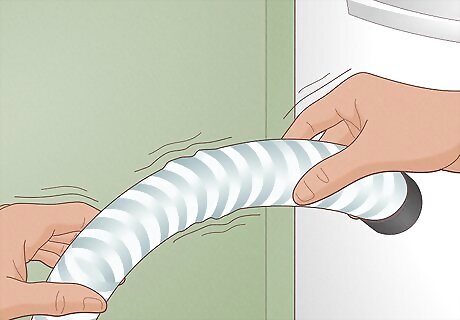
Break up clogs physically. Take the hose in your hands and bend it back and forth every few inches for the entire length of the hose. This will loosen severe blockages and may even resolve light clogs. If you feel more resistance than usual when bending the hose, there is likely a blockage. Target these areas. While you’re physically breaking up clogs, keep the end of your hose positioned over your drip pan or a bucket to catch anything that falls out.
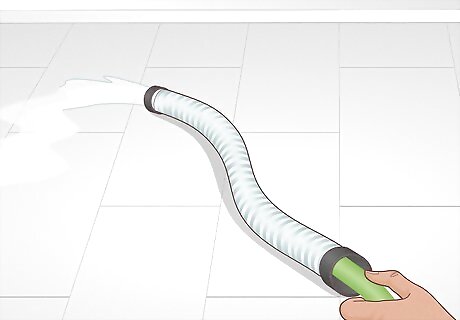
Flush the drain hose with a garden hose. A directed stream of water should be able to flush out your clogs. Hold a garden hose to one end of your drain hose and turn on the water supply for the garden hose to eject blockages. Faucets with similar pressure to a garden hose can be used in the same way as garden hoses. Hold one end of the drain hose to the faucet and turn it on full pressure to flush out blockages.
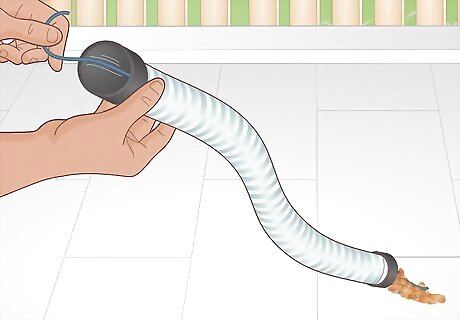
Snake the hose for stubborn clogs. Use pliers to straighten a wire coat hanger. When completely straight, pass the hanger through the hose and push it out through the other end. This technique is especially useful for severe blockages. Take care to completely straighten your coat hanger. Bent ends can catch on the corrugation of the drain hose, damaging it.
Unblocking the Recirculation Hose
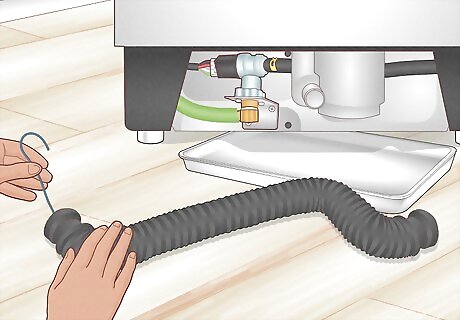
Apply unclogging techniques to the recirculation hose. The recirculation hose should be fastened to the pump in the same way as the drain hose. Position your catch pan, remove the hose, physically loosen the clogs, and apply flushing and snaking techniques as necessary.
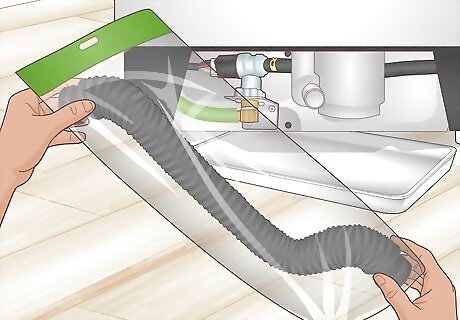
Replace hoses that cannot be unblocked. In the rare case that your blockage is too severe to be removed by flushing or wire hanger snaking, you may need to replace your hose. Replacement hoses can be bought at your local hardware store, home center, or by ordering them from the manufacturer in the fashion described in the dishwasher’s manual. If there don’t seem to be any issues with your hose or if you’ve replaced it and it still drains poorly, the issue may be with the drain. In this case, you’ll likely have to unclog it.
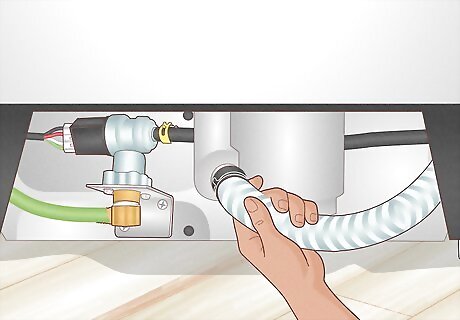
Reconnect the hoses. Use firm pressure to push hoses back onto the pump connections. Slide the wire clamps back up hoses to their original position at the hose/pump connection. Pinch clamps with your pliers until they are firmly fastened.
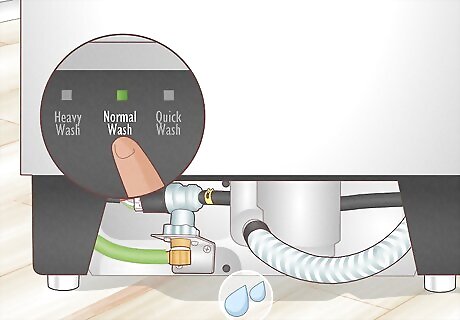
Check for leaking hoses. After replacing the hoses, return power to the dishwasher and then run a normal cycle while it is empty. Watch it as it runs to verify everything that is properly connected and nothing is leaking. If you notice any abnormal leakage while running your dishwasher, turn it off immediately and disconnect it from power. Refasten the hoses that leak. Persistent leaking may be an indication you need to replace a hose.


















Comments
0 comment